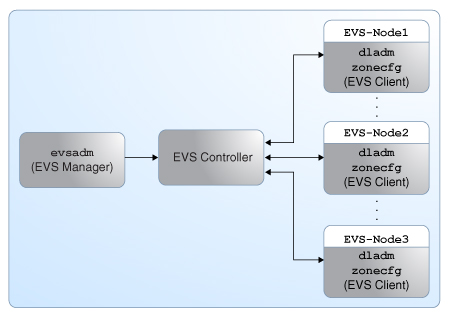EVS Components
EVS has the following components:
-
EVS manager
-
EVS controller
-
EVS clients
-
EVS nodes
The following figure shows the components of EVS.
Figure 18 EVS Components

In this figure, the EVS manager and the EVS controller are two separate hosts. The EVS nodes EVS-Node1, EVS-Node2, and EVS-Node3 are three hosts whose VNICs or zone's VNIC anet resources connect to an elastic virtual switch.
EVS Manager
The EVS manager is the entity that communicates with the EVS controller to define the L2 network topologies and the IP addresses for these L2 networks. The EVS manager communicates with the EVS controller through the evsadm command. The EVS manager and the EVS controller can also be on the same compute node.
Note - The L2 network topologies are the network segments and each segment forms a single broadcast domain, which is implemented by using VLANs or VXLANs.
EVS Controller
The EVS controller provides functionality for the configuration and administration of an elastic virtual switch and its associated resources associated. You must set up only one physical machine as the EVS controller in a data center or multitenant cloud environment.
To implement the L2 segments across physical machines, you would configure the properties of an EVS controller with information such as available VLAN IDs, available VXLAN segment IDs, or an uplink port for each EVS node.
Note - You can also push the EVS controller information to each of the EVS nodes in the data center or multitenant cloud environment by using SMF site profiles and the Auto Install (AI) service. For more information about SMF, see Managing System Services in Oracle Solaris 11.4. For more information about AI service, see Working With Install Services in Automatically Installing Oracle Solaris 11.4 Systems.
The following table lists the EVS controller properties.
|
Controller properties are applicable to the entire data center or multitenant cloud environment. However, you can override the values of the controller properties uplink-port and vxlan-addr by specifying the host to which those property settings should apply. For example, the following syntax sets the uplink port net1 as applicable only to host1:
$ evsadm set-controlprop -h host1 -p uplink-port=net1
EVS Clients
EVS clients are systems that are serviced by the EVS controller.
Clients can be physical systems or virtual machines (VMs), which in Oracle Solaris, are synonymous with non-global zones. The typical commands for configuring EVS clients are dladm, evsadm and zonecfg.
When VNICs are created for the elastic virtual switch, the configuration information for VNICs is retrieved from the EVS controller.
EVS Nodes
A connection between the elastic virtual switch and a VNIC constitutes a node. EVS clients are EVS nodes if their VNICs are configured and connected to the switch. You can use commands such as dladm and zonecfg to specify VNICs that need to be connected to an elastic virtual switch. For more information, see Configuring EVS Nodes.
Restrictions in Configuring EVS Components
If you deploy an EVS on your site, some restrictions are apply when you administer the following components on the switch:
-
VNICs – When these are connected to the switch, then you cannot modify them, change their names, or change their properties.
-
VXLANs – When you implement VXLANs on elastic virtual switches, VXLAN datalinks are automatically created on the EVS nodes that hosts VNICs for the EVS. These datalinks are identified as evs-vxlansegment-ID, such as evs-vxlan200, to indicate that EVS was the creator of the datalink.
You cannot rename or delete these type of datalinks. However, you can temporarily set their properties by using the appropriate dladm command options.